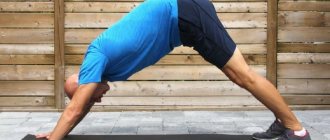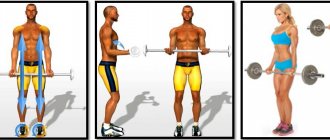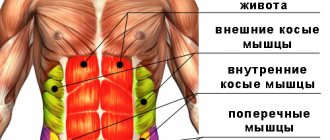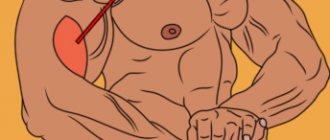Why don't my shoulders grow? 5 reasons
The deltoids have a sacred meaning for any athlete, along with the pecs and biceps: of course, because these most fragile shoulders bear one of the most serious missions - to form that very V-shaped figure that will tell everyone for you: you are firmly friends with fitness. However, it often happens that friendship with bodybuilding does not bring results, and deltoids do not want to increase in size. Why don't my shoulders grow? Today we will look at 5 reasons why deltoids refuse to increase in size despite your diligence in the gym.
Why don't my rear delts grow?
The posterior bundle of deltas is called the “lazy” bundle. Even professional bodybuilders have a posterior bun size that is only a third larger than that of an average person.
There are several reasons for this.
- Firstly, the front part of our deltas takes an active part in other exercises, or rather in all types of chest or triceps presses, while the rear part does not receive any load.
- Secondly, the back bun is not as popular as, for example, the biceps, back or pectoral muscles, which we always look at in the mirror. Therefore, less attention is paid to it.
- Thirdly, as I already said, the rear beam is the smallest in size, so it is difficult to include it correctly in the work, it is difficult to correctly direct the load. All this leads to the fact that exercises for the rear deltas are often done incorrectly, and the result is a lack of growth.
Weak development of deltoids
Deltas do not like the same type of exercises and insufficient attention during training. So if you do overhead presses on your shoulders, and only overhead presses, be prepared for the fact that your deltoids will not grow the way you want them to. Remember: the deltoid muscle consists of three bundles , and most exercises for the anterior and middle bundles almost do not include the back one and vice versa. It is for this reason that the training should be balanced: include in the training the barbell overhead press, military press, barbell row to the chin and swings forward to the sides and back. Combine these exercises, combine them, master the technique of drop sets and pumping. The main thing is, if your deltoids are not growing, do not limit yourself to one or two exercises, but make your shoulder training moderately long and varied.
Anatomy of deltas
To understand how to build big shoulders, you need to understand how they work. The deltoid muscles completely surround the shoulder joint, partially covering the shoulder muscles and extend to the humerus, where they are attached to the upper part of it. It consists of three bundles:
- Front bun. It originates from the anterior edge of the clavicle. Responsible for raising your arms in front of you, as well as for moving your elbows toward your body.
- The middle bundle is attached to the top of the shoulder blade. The task is to raise your arms to the sides.
- The posterior bundle starts from the posterior edge of the scapula. Pulls his hands back.
Working together, all three muscle bundles allow for a wide range of movements, making the shoulder joint the most mobile joint in our body. By fully contracting, the delta can move our shoulder forward and backward, down or up.
Emphasis on the positive phase
Why don't your shoulders grow , even if you spend enough time on them in the gym and combine different exercises? The answer may be simple - often even professional athletes emphasize the positive phase of the barbell or dumbbell movement: they slowly lift the weight and then quickly lower it. With the shoulders, as with many other muscle groups, you need to do exactly the opposite: lifting the weight should be quick and clear, and the negative phrase should be measured . In it, you must make a muscular effort to resist the weight and slowly lower the weight. Try to place emphasis in the exercises in a new way, and you will definitely see a completely different result!
The load is taken by the trapezoids
For all deltoids exercises, the shoulders should be lowered down and not lifted up by the trapezius.
A fairly common mistake made by beginners is cheating during shoulder exercises, when the trapezius involuntarily rises to the ears and helps pull the weight. Needless to say, with this balance of power, your deltoids receive far from the full portion of the load. That is why, in all exercises for the deltoids, the shoulders should be lowered down and not raised up by the trapezius. Monitor this especially carefully when performing dumbbell swings and crossovers.
Weight does not increase
The main condition for permanent muscle hypertrophy is increasing working weight . So if your weight doesn’t change and your deltoids don’t grow, there’s a reason to move on. at least 2.5 kg more weight in your next workout . Yes, this may have a negative impact on the number of repetitions, but this is not a problem. Do the bench press as many times as you can, then the next workout increase the number of reps by 1, then by 2, and so on. Little by little you will come to the number of repetitions you are accustomed to, but with more weight, and your deltoids will surprise you by adding in volume.
Downloading deltoids: Superset!
Superset: barbell row to the chin + dumbbell lateral raises
Next in the program is a superset, which combines two exercises of 15 repetitions. First, we do rows of the bar to the chin (15 reps), then without rest we begin to raise the dumbbells to the sides (15 reps). The total time to complete the exercise is 40-50 seconds.
Smith machine bar to chin row
Denis Gusev also does bar-to-chin rows in the Smith machine. This gives him the ability to better isolate the deltoids.
Dumbbell lateral raises
Immediately after the deadlift, we move on to lateral raises.
Superset: Shrugs + dumbbell bent over flyes
The trapezius muscle is quite actively involved in the work during training of the muscles of the shoulder girdle. Therefore, training the trapezius along with the deltoids is a fairly rational solution. The author of the master class combines shrugs and bent-over dumbbell flyes into one superset. Number of super series: 3.
Shrugs in the Smith machine
A prerequisite when performing the exercise is a delay of 1-2 seconds at the top point of the amplitude. Number of repetitions: 20.
Bent-over dumbbell flyes
This exercise is aimed at working the rear deltoid. Be careful when performing this exercise. To maximize the load on the rear deltoid, try to move your elbows slightly forward. If you feel that it is not possible to perform this exercise technically, you can resort to an alternative solution - arm abductions in the butterfly simulator while sitting facing the back of the bench. Number of repetitions: 10-12
Thus, in this superset, the total number of repetitions varies between 30-32.
Insufficient number of repetitions in the set
Unlike most other muscle groups, shoulders love high-repetition sets.
If you are successfully following all the previous recommendations, but you still have the question “why your shoulders don’t grow,” there is one more important detail. Not doing enough reps per set can also cause your shoulders to be underloaded and not grow. Here it must be said that, unlike most other muscle groups, shoulders love high-repetition sets. So if you're limiting yourself to 6-9 reps, that might be good for the chest, but it's definitely not good enough for the shoulders. Increase the number of repetitions to 12-15 , and the effectiveness of your training will increase by an order of magnitude.
By the way, to increase the number of repetitions, you can use the drop set method and lose some of the weight at the moment of failure. Just remember - it’s better not to abuse this technique and use drop sets no more than once a month.
Now you know why your shoulders don’t grow and how to avoid mistakes and stagnation in training. Follow our five tips, and you will definitely see progress, and your deltoids are guaranteed to grow. But remember: one of the main tips when training deltoids is not to get hung up on one technique , alternate loads and include new exercises for 2-3 months. This is the only way your muscles will not get used to the existing loads and will be able to grow confidently.
Delt training program: Exercise 1
Seated dumbbell press
What are broad shoulders? This is, first of all, a developed middle delta. According to Denis Gusev, an excellent exercise for the middle delta is the seated dumbbell press. This choice is justified by the fact that:
- Maximum weights can be used
- Unlike the vertical barbell press, when performing exercises with dumbbells, stabilizer muscles are additionally activated
- By using dumbbells, you can increase the range of motion by lowering the dumbbells lower
Therefore, the first exercise in training deltas is a basic multi-joint exercise with free weight, namely the dumbbell press.
Problem: You're the Last to Focus on Your Deltoids
Concentrating all your attention on the muscles of the chest, back and legs is very good. After all, these are the largest muscle groups in the body that produce the most mass and strength. But let's be honest, if you completely neglect your deltoids, you won't be able to build really big, muscular shoulders.
How to fix it: Make deltoid training a priority. Do you want a serious approach? Set aside one day just for them or put them first in arm training, for example. Don't think of your shoulders as small, weak muscles that don't deserve much attention.
2. Problem: You're using too much weight with poor conditioning Train each head of the deltoid (front, side, back) as a separate muscle. While training your shoulders, focus on your arm work and thoroughly explore your potential for better and more effective exercises.
Admit it, are you turning your shoulder press into an incline press and only using half the range of motion? Conclusion: You are using too much weight!
What about dumbbell lateral raises? Are you twisting, swaying and losing your rhythm? And how does this work for you?
How to fix it: The best way is to cut your current weight by almost half, but at the same time achieve ideal exercise performance by doing them regularly. Your job is to practice the movements, bring them to automaticity, so that your shoulders “remember” the algorithm, the correct contraction and control. This will increase strength and protect your deltoids from damage. When you focus on practicing the movements, you will see improvements in muscle mass and real, functional strength.
The correct technique and types of exercises to pump up the rear delts
Unlike the front deltas, the main purpose of the rear ones is to pull and pull the limbs back, so they are trained with the help of rows and swings. Of these two types of exercises, I recommend doing deadlifts, since deadlifts are more basic exercises that work several joints at once. This provides more exercise, a greater release of hormones and, as a result, leads to better growth. In addition, working with basic exercises allows you to use the principle of progression of loads, you will be able to work with large weights.
So, let's move on to the exercises:
- Lee Haney deadlift. Invented by an 8-time Mr. Olympia title winner, this deadlift is the best basic exercise for the middle and rear deltoids. We take a position with our back to the bar mounted on a rack or in a power rack. Straighten your shoulders, feet shoulder-width apart. We take the barbell with a reverse grip, straighten our arms so that the barbell is just below the butt and begin work. We lift the barbell with the help of deltas and trapezius to approximately the level of the lower back, hold for a second at the end point, and then lower the barbell. The exercise technique is quite complex, so I advise you to familiarize yourself with the attached video.
- Bent-over barbell row. Performed in the same way as the variation for the back. The only difference is the angle of inclination: it is significantly lower. We approach the bar (this time from the front), take a position: feet shoulder-width apart, back straight. We lean forward with the barbell at an angle of 90 degrees, take the barbell with a wide grip and pull it with the help of the rear deltoids to the chest. It is important to maintain a 90 degree angle between your arm and shoulder. Gives a good load on the middle deltoids as well.
- Bent-over dumbbell raises. We take the starting position and bend down, take dumbbells in our hands and raise them to the sides and slightly forward. We hold the dumbbells with a horizontal grip so that the trapezoid does not steal the load. Many people do this exercise by resting their head on a bench. During work, we do not allow dead spots - the shoulders should be in motion throughout the entire exercise. Can be performed either standing or lying face down on an inclined bench.
I will separately highlight exercises in the crossover:
- Bent over swings. The essence is the same as with dumbbells, the elbows should be turned towards the ceiling, we try to look at the floor.
- Swing on the top block. We take the handles of the crossover in our hands so that the cables intersect. We get into the starting position, feet shoulder-width apart. The elbows are in a fixed position, we pull back with the help of the rear deltoids, we try to focus and feel the work of the muscles. It is important not to spread your arms completely; they should be slightly bent and fixed.
Problem: You've overtrained your anterior deltoid.
Next time you're at the gym and someone is training your deltoids, take a closer look. Are they performing dumbbell presses, machine presses, and dumbbell front or side swings? In reality, only the mass of the front head is working. Not only is this an overshoot, but it also has a negative impact on other exercises such as the bench press.
How to fix it: Reduce your shoulder training to one exercise for all three heads of the deltoid muscle. Let it be a bench press and, if this is not enough, lifting dumbbells in front of you. This will protect you from overtraining your anterior deltoid so you can focus more on future shoulder training.
How to pump up shoulder muscles
Shoulder training is a rather complex process due to the specifics of their structure. In particular, the formation of the shoulder occurs with the participation of the deltoid muscle, consisting of 3 bundles - anterior, middle and posterior.
front beam
medium bun
back beam
It is the uniform development of the three bundles of the deltoid muscle that ensures the uniform formation of the shoulders, which has a positive effect on the athlete’s figure.
How to pump up your front delts
Lifting dumbbells in front of you . In this case, the emphasis is on the anterior bundles of the deltoid muscle. It can be performed with two dumbbells at once (they can be lifted one by one or synchronously), with one dumbbell, with a barbell plate, with a barbell, and also in a simulator.
A fairly simple and yet effective exercise that allows you to develop the deltoid muscle. Lifting dumbbells should be done with outstretched arms. Be sure to keep your back straight, focusing on the execution technique.
You should focus specifically on performing this exercise, and not on the weight of the projectile.
How to pump up your middle deltoids
Standing lateral raise of dumbbells . This is a classic exercise aimed at developing the deltoid muscles that surround the shoulder joints. It is the middle deltoids that are most involved when lifting dumbbells to the sides.
While moving the dumbbells in different directions, you need to keep your back straight. Avoid bending and rocking. Only movements of the shoulder joints are allowed. You cannot raise your shoulders while performing dumbbell curls - in this case, the load will fall on the trapezius instead of the shoulders.
Your elbows should be slightly bent. Start slowly lifting the dumbbells in both directions without haste or jerking, maintaining strict verticality (moving your arms forward or backward is unacceptable, moving your arms only upwards).
Retract your arms without jerking, using only the efforts of the shoulder muscles. You should take short breaks at the top and bottom points.
How to pump up your rear delts
Bent-over dumbbell raises . You need to take dumbbells, tilt your body to a position almost parallel to the plane of the floor, keeping your back straight. Raise your arms to the sides until they are parallel to the floor, with your elbows slightly bent. As you inhale, lower the dumbbells to the starting position. It is unacceptable to bring the blades together, otherwise the load on the trapezoid will shift.
Each exercise for the rear deltas should be repeated 12-15 times, since slow muscle fibers dominate in this area. Using heavy weights will negatively impact your technique, which is more likely to cause injury than growth.
The back surface of the delta recovers extremely quickly, for this reason it can be trained two or three times a week.
Problem: You're contracting your deltoids incorrectly
This problem goes hand in hand with doing the exercises correctly. Effectively reducing our deltoids is not possible if you have chosen heavier weights but neglected the execution. If you have made lifting weights your main goal, then not only the deltoids, but also other muscles will work to lift the weight. In addition, you are risking your health.
How to fix it: As we said, focus on exercise technique and careful contraction of the working muscles. This way you will properly stimulate the muscle and get better results.
For example, don't tilt the bench back so much that your shoulder press turns into a chest press. Sit straight, below the dumbbells so that they almost touch your shoulders. Then lift the weight, but without clanging at the top. Elbows back, in line with your shoulders, slowly and gradually.
Problem: You're doing too few reps
While you're going for a 1 rep max or trying to get into powerlifting, there's really no point in adding weight and it's worth aiming for super slow reps to train your shoulders. For the average lifter, chest and back training is sufficient.
How to fix it: If you've been training with heavy weights recently, lighten it up just a little and try doing a little more reps. Note, more repetitions, not the easier version. The relief should be subtle so that the workout doesn't feel like a walk in the park. You will still train to exhaustion on every set. Aim for 10-20 reps. You'll quickly find your rhythm and realize that more repetitions will accelerate muscle growth.
Problem: You're not working the lateral heads of the deltoids at all.
The width of the muscular shoulders largely depends on the size of the lateral deltoid head. This is the part of the deltoid muscles that gives your shoulders a broad, V-shape. However, most beginner athletes do not pay enough attention to the middle deltoids. Instead, they choose presses and lateral swings for wide form.
How to Fix It: If width is what you're looking for, then you're best off focusing on the middle lateral heads rather than the other deltoid heads. Raising your arms to the sides while standing and sitting, lifting dumbbells and barbells on the deltas and raising your arms to the side from the lower block, various simulators for lateral raises are completely at your disposal. Include 2 exercises for the lateral head of the deltoid in your program to enhance their growth.
Deltoid training program
Seated dumbbell press
| an approach | repetitions |
| 1 | 20 |
| 2 | 20 |
| 3 | 16 |
| 4 | 12 |
| 5 | 8 |
* rest between sets 90 seconds
** first two sets are warm-up
Smith machine press
| an approach | repetitions |
| 1 | 50-60 |
| 2 | 50-60 |
| 3 | 50-60 |
** every 10-12 repetitions it is necessary to fix the projectile at the top point for 30 seconds. After the pause, do another 10-12 repetitions and again fix the weight for 30 seconds. Within one approach, perform 5 cycles, which is a total of 50-60 repetitions.
* rest between sets 3 minutes
Superset: barbell row to the chin + dumbbell lateral raises
| an approach | barbell row to the chin | dumbbell lateral raises |
| 1 | 15 | 15 |
| 2 | 15 | 15 |
| 3 | 15 | 15 |
* rest between sets 1.5-3 minutes
Superset: shrugs + dumbbell flyes
| an approach | shrugs | Bent-over dumbbell flyes |
| 1 | 20 | 10-12 |
| 2 | 20 | 10-12 |
| 3 | 20 | 10-12 |
** when performing the shrug exercise at the top point of the amplitude, you must hold for 1-2 seconds.
* rest between sets 1.5-3 minutes
Superset: pulley lift + plate rotation
| an approach | raising the lower block | pancake rotation |
| 1 | 14-16 | 14-16 |
| 2 | 14-16 | 14-16 |
| 3 | 14-16 | 14-16 |
* rest between sets 1.5-3 minutes
You can find recommendations, nuances and instructions regarding the implementation of this deltoid muscle training program below.
Warm-up
Before training, I always warm up on a cardio machine (elliptical or treadmill) for about 7 minutes until my heart rate reaches 140 beats. After this I do some body stretching. Before training the deltoids, I additionally do exercises to strengthen the rotator cuff and warm up the stabilizer muscles. These are all kinds of rotations of the arms in the shoulder joint and swings to the sides with small dumbbells.
Warm-up exercise 1: Rotational movements in the shoulder joint with light weights. The arms are bent at the elbow joint.
Warm-up Exercise 2: Rotational movements forward and backward with small dumbbells.
Warm-up exercise 3: Side swings.
Problem: You have an unbalanced training program
The points listed above come down to balance. Training your shoulders with a ton of presses, a small amount of lateral raises, and no posterior deltoid work is not a good workout. If you continue in this manner, your shape will become disproportionate, with shoulders that are pumped in front (slouched shoulders).
How to Fix It: If you are someone who likes to press too much, then the answer is very simple. Add 2 exercises for the lateral head and 2 exercises for the posterior head. Concentrating on these areas slowly, but will still make your figure proportional, as it will improve the growth of muscle mass in these areas.
Problem: You're not using super sets or giant sets.
Are you mentally stuck in a sequential set? If so, we're willing to bet that shoulder training is pretty boring, if not downright boring. It is very difficult to stimulate any muscle growth by repeating the same exercises for weeks! Your deltoid muscles are screaming for something new!
How to fix it: Working your deltoids is one of the best opportunities to try out the benefits of supersets or giant sets. There is no problem doing exercises with dumbbells and excellent equipment in the gym. The simplest giant set might look like this: standing dumbbell lateral raises, bent over dumbbell lateral raises, standing dumbbell overhead press, standing dumbbell front delt raise. Do 3-5 sets of 10-20 reps for each exercise, resting 2 minutes between each giant set.
What to do if your biceps don't grow
The main goal is to prevent the biceps from adapting to the load. To do this, you need to change the set of exercises every 2-4 workouts (for professional athletes). Beginners can change the program a little less often.
The following factors are no less important:
- Training frequency. Optimally – 1 time every 1-2 days. It is not worth training more often, since the biceps need time to recover.
- Number of repetitions. The biceps is a muscle that loves a lot of repetition. This helps to achieve both relief and volume. To grow a muscle, 8-12 repetitions are needed, to increase strength – 6-8.
- Number of exercises. During training you need to do 1-2 exercises on the biceps.
- Progressive increase in load. This is a good stimulating factor. The bottom line is to increase the working weights every 1-3 workouts.
- Varied load. In addition to the usual barbell curls, it is necessary to include at least 2-3 more exercises in the program, since variety will not allow the muscles to adapt and get used to the load. These could be curls with dumbbells or a barbell, pull-ups with a reverse grip, or curls on a Scott bench.
- Execution technique. When lifting a barbell or dumbbells for biceps, your elbows should not move. All movement should occur only by bending the arms at the elbow joint. Additionally, you need to lower the barbell slowly and smoothly to feel the load on your biceps.
- Correct grip. When training for biceps, it is also important how correctly the athlete holds the apparatus. For biceps, a reverse grip is considered ideal.
- Application of additives. Creatine, which can be taken after training, is especially effective for increasing muscle mass. But there are other useful sports supplements (more on them below).
We recommend:
On this topic:
Daily pull-ups on the horizontal bar - pros and cons
Problem: Your training frequency is too low
One important factor to pay attention to is how often you train your shoulders. One workout per week will seem normal to most. But this won't help at all if your goal is to improve your shoulder shape. Why wait until next week to train your delts again?
How to fix it: Let's do the math. If you train your shoulders once a week, you have a 52 chance per year of increasing shoulder growth. If you train them twice a week, you instantly increase your odds to 104. Which choice will get you closer to your goal faster? If you are doing everything correctly, then perhaps training too infrequently is your problem in shoulder growth. Plus, the fact that you'll be training your shoulders twice a week requires a lot less effort on your part since you're doing
Shoulders don't grow
Shoulders not growing is a fairly common problem, since during shoulder training athletes often make a lot of mistakes due to the fact that the shoulders consist of three bundles that perform different functions. Shoulders do not grow, most often due to the fact that athletes do not progress the load during their training. Or rather, they progress, but only in bench press exercises, and in deadlifts and swings the weights remain the same for many years. This happens because athletes do not use basic exercises to train their shoulders, while barbell rows to the chin and barbell rows while lying down perform the function of basic exercises for training the rear and middle deltoids. It is also worth noting that bodybuilders should perform seated and standing presses in the same way, with an emphasis not only on the anterior deltoid, but also on the middle deltoid, which is ensured by moving the elbow back. The bottom line is that the working delta is the one that is located above the axis of the shoulder joint at the moment of effort.
So, shoulders always don’t grow because they are simply not trained correctly, so the first thing you must remember: you need to train all the deltoids, especially the middle and back ones, since they are the ones responsible for the volume of the shoulders, and training should be progressive in nature - the load should increase ! You probably know that basic exercises are the most effective for increasing mass and strength, since it is easiest to increase working weights in them, and progressing the load by increasing working weight is most effective for stimulating hypertrophy of muscle fibers. The problem with shoulders often lies in this, since there are not many basic exercises for training the rear and middle deltoids, and not everyone uses them, which does not allow athletes to increase working weights. Therefore, the first thing you need to do is include a “base” in your shoulder training. Secondly, in order to progress not only in basic exercises, but also in isolating exercises, you must either use “cheating” or progress the load not due to weight, but due to other factors, as Stanislav Lindover talks about in detail!
Why don't my biceps grow?
The main reason why biceps stopped growing can be called muscle adaptation. It manifests itself in the fact that over time, exercises begin to produce less and less results. As a result, muscle growth rates slow down and even turn into negative dynamics. In simple words, this is the muscles getting used to the load.
If the biceps are not growing well, the reason may be a program in which the athlete tries to work all the muscles in one workout. This causes fatigue: muscle tissue does not have time to recover, which affects the rate of their growth.
We recommend:
On this topic:
Detailed training program in the gym for men 3 times a week (+ nutrition rules)
Another reason for lack of growth is the inability to pump the biceps. If the technique is incorrect, the muscle simply is not stimulated.
Another equally common reason is poor nutrition. If you consume few calories and train with sufficient intensity, then your muscles will simply have nowhere to take energy and building material to increase volume.
We recommend:
On this topic:
Nutrition for energy before training: proper nutrition and sports nutrition | When and what to eat
Shoulders not growing bodybuilding
My recommendation is to pump as much blood into them as possible.
The brutal burning grows the shoulders better than the maximum working weight. How to achieve it? Increase time under tension as muscle contraction restricts blood flow. With the shoulders, we cannot apply the external blood flow restriction (BFR) technique, so the best option remains to extend the approach by any means: drop sets, supersets, etc.
One of my favorite supersets keeps my shoulders tense for more than a minute, here it is:
First I do lateral raises for 15 strict reps, followed immediately by a static overhead bar hold for 45 seconds. Do this superset 4 times and your shoulders will be bursting with pump!
Amit Sapir, IFBB professional, world record holder in squat:
Need some shoulder mass? Mix all methods!
Usually a muscle group only needs a couple of compound exercises and hard work to grow, but with shoulders it's not so simple. Why? Because they have several bundles that respond to various stimuli. The rear muscles grow better from multi-repetition sets and increased time under load. But to gain mass in the front and middle beams, you need to add heavy bench presses.
So here are the two main secrets for training shoulders for mass:
- Variety (lots of exercises, working from different angles)
- Time under load. The amount of working weight fades into the background when it comes to the shoulders.
Naturally, I don’t encourage you to press dumbbells as much as 2.5 kg, but super strict execution of the exercise with perfect technique will give more weight to your shoulders. Since I personally am not a fan of high-repetition sets, I prefer to combine several exercises into giant sets, varying the angles and tempo. For example, like this:
I start with heavy overhead presses; In the first half of the set, I stop the bar at ear level and hold a pause for 2-3 seconds, and finish the second half in a normal rhythm without pauses.
Then two variations of side lifts: first with the body tilted, then standing straight - so that there are more angles to work out.
And I finish everything with raises for the rear fascicles, here I have to do my best in a large range of repetitions, concentrating on contracting the muscles at the top point. Try to hold the peak contraction for 2-3 seconds at least in the first half of the approach. In general, having understood my idea, you can choose the exercises to your liking, the number of options is endless.
Christian Thibadeau, weightlifter, bodybuilding coach and strength specialist:
To train your shoulders for mass, give more isolated loads from different angles.
For shoulders, I prefer compound approaches, which I call “growth factor”: 2-4 exercises are performed non-stop. The muscles remain under load from a minute to two.
It is clear that heavy bench and standing presses add mass to the shoulder girdle, but they only develop the anterior fascicles. And the stronger these segments become, the more they intercept the load, and therefore it is more difficult to stimulate the middle bundles. The overhead press distributes the load across all the beams, but just don’t use a lot of weight in it (unless you’re Paul Carter or Dmitry Klokov).
Try this combination: standing press first for strength and athletic performance - many sets of 3 reps at 80-85%. Work hard enough to stimulate fast-twitch fibers and activate the nervous system; but, of course, not so hard as to damage the shoulder joints.
Then add training volume with supersets for growth: combine 2-4 exercises (front raises, lateral raises, rear flyes, arm circles, Scott presses, etc.), performing 6-10 reps of them with light weight so that the shoulders are under load for 1-2 minutes. I do 3 supersets, resting 90 seconds between each set.
The shoulder muscles turned out to be somewhat more complex than we previously thought: they have not three bundles, but more. At the same time, the shoulder joint is the most mobile in the body, which is why it is important to work the shoulders from different angles, both for the full development of muscles and for health.
Chris Shugart, creative director of T-Nation:
Add block machines to traditional strength exercises.
Of course, the basis of training for shoulder mass will always be the good old standing barbell press, but blocks are also useful for pumping up big shoulders.
Most exercise machines are pretty poor: they limit movement in one plane, but that's not how shoulders work in real life. And block simulators give you more freedom; many years ago, Charles Poliquin wrote on our website that blocks are as effective as dumbbells and in some ways even superior to them. Here are their advantages (for shoulder training):
- Quick load switching – allows you to perform drop sets, extended sets, partial reps and holds. These are all proven methods for gaining shoulder mass. Using a machine, it’s easier to increase your time under load because you don’t have to grab another pair of dumbbells or remove weights from the bar.
- Variety of exercises - after a set of overhead presses, you can reduce the load and finish off your shoulders with burning raises through the sides or in front of you. And all this on one simulator, without running around the gym - which is especially convenient during rush hours.
- Different grips – thanks to a rich set of handles, you can change your grip right in the middle of the approach: wide, narrow, straight, reverse, neutral. And also switch from two-handed to unilateral without unnecessary delay.
- Angles of study - the block simulator gives maximum freedom in choosing the angle and trajectory of movement. I recently injured my shoulder while pulling a bus full of nuns out of an abyss (I fell at home after tripping over a dog). I had to forget about the barbell for a while, but on the block simulator I was able to select such a movement and load to continue training and speed up recovery.
Shoulder training program in the gym
Shoulder training consists of basic and isolation exercises. Basic exercises involve the participation of two or more delta bundles, as well as sometimes trapezius, while isolating exercises involve the participation of only individual bundles.
Basic exercises are performed using maximum working weight.
To build shoulder mass, you need to start every workout with compound exercises (such as overhead presses) that allow you to lift a lot of weight. Then you need to do isolation group exercises for each of the 3 delta muscle bundles: anterior, middle, posterior.
Isolation exercises should be done with a light working weight, allowing you to perform 12-15 repetitions.
The workout should include 1-2 basic and 1-2 isolation exercises.
| Standing barbell press | 3x6-8 |
| Seated dumbbell press | 3x8-10 |
| Lateral lift | 3x10-12 |
| Bent over rise | 3x12-15 |
Rest between sets for 60-90 seconds. Rest between sets should be 2-3 minutes.
The front deltoids do a significant amount of work during chest training. For those who are not professional athletes, there is no point in training them separately. For this reason, the exercise “raising dumbbells in front of you” is not part of the training program.
This program is universal in nature, it is suitable for almost everyone, regardless of the level of preparation. It involves all 3 bundles of the deltoid muscles of the shoulders and helps to increase their muscle mass.
Only a full load on all muscle bundles and fibers will help make your shoulders harmonious on all sides and voluminous.











